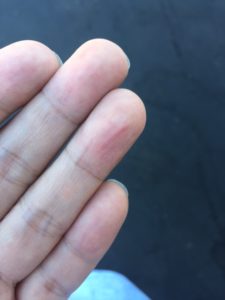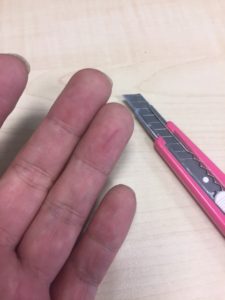
- Written:
- Author: Edward
- Posted in: dr ed park, RECHARGE, stem cells, TA-65
- Tags: achilles tendon, cycloastrogenol, Dr. Ed Park, finger lac, past lives, recharge, sports injuries, ta-65, wound repair
Yesterday, I was rushing through a shipping task and clumsily sliced open my ring finger to about a 1.5mm depth. Predictably, blood came gushing out and so I put some alcohol in it and wrapped it up with micropore tape.
 Less than 24 hrs later, after doing yoga handstands on it and taking 3 capsules of containing Recharge, I un-bandaged the finger to find this:
Less than 24 hrs later, after doing yoga handstands on it and taking 3 capsules of containing Recharge, I un-bandaged the finger to find this:
It seemed odd because I remember what a finger laceration used to entail. There would be disunion, a scab that would form, and perhaps days to weeks of a remodeling and weakened scar. I can’t help but think that accelerated local stem cell replication helps healing, perhaps because telomere restoration is a potential rate-limiting-step in healing.
Interestingly, when you do fetal surgery, the baby is usually born without scarring. I would guess that the lack of bacteria, mechanical stress, and anti-inflammatory cytokines help. But could it also be that the quality of the local and progenitor stem cells is higher and that this efficiency represents not only a lack of differentiation but a paucity of epigenetic and genetic commitment and its attendant inflexibility?
Many clients taking adaptogens report rapid healing but I would like to compare and contrast with an email I received from a patient this week who was going to quit TA-65 because he had muscle aches and a sore Achilles’ ligament:
I took 8 daily for 2 weeks and experienced negative symptoms including a variety of muscle stiffness issues and also I developed Achilles pain in thesame time.
I had a similar loss of faith and some faulty attribution with my own Achilles’ years ago and I blogged about it here.
To learn more about Achilles’ ligament injuries, watch this podcast that I did.
In a nutshell, I thought the TA-65 was causing the problem but stopping made it worse and doubling my dose made it go away. So how can I reconcile that? Well, my patient and I both felt there was a relationship but we failed to see what was underlying- the injury to the tendon.
Because the tendon was injured, the inflammation, repair, and mechanical compromise were heightened. Instead of being a fixed constant, the acceleration of repair also left the ligament prone to re-injury. Sort of like not waiting for concrete to dry before walking on it.
Interestingly, I often find that muscle and tendon soreness in the first two weeks of starting an adaptogen a very auspicious sign in my patients. The majority of people correctly recall an old injury and they report that the pain resulted in a new normal of no pain after a few days – in other words, old scars were being remodeled and younger, better cells and connective tissue were being laid down.
So a word to the wise: pain is not weakness leaving the body. It is a sign that there is inflammation and something that is easily reinjured if you don’t pay heed. Adaptogens can’t change the physics of movement or repair but I believe they can accelerate the normal processes; but you can’t walk on wet concrete and not expect to leave some footprints. Watch this video on sports injury for more info:

ADDENDUM- This is my 1.5mm finger laceration at 48 hrs. I don’t remember this healing taking place as quickly in pre-adaptogen life. (disclaimer- the featured image is obviously a different person and finger but Doug Malewicki asked me about it so I wanted to clarify. I didn’t have the foresight to take a “before” picture).
If you think that the notion of telomerase activity is unrelated to wound healing, you only need to consider that the mutation of the gene causes poor wound healing and slow nail and hair growth in Dyskeratosis Congenita.. Localized tissue regeneration requires stem cells to expand rapidly and the natural experiment of poor telomerase activity leading to poor wound healing proves the contrapositive of high telomerase activity leading to rapid wound healing.

